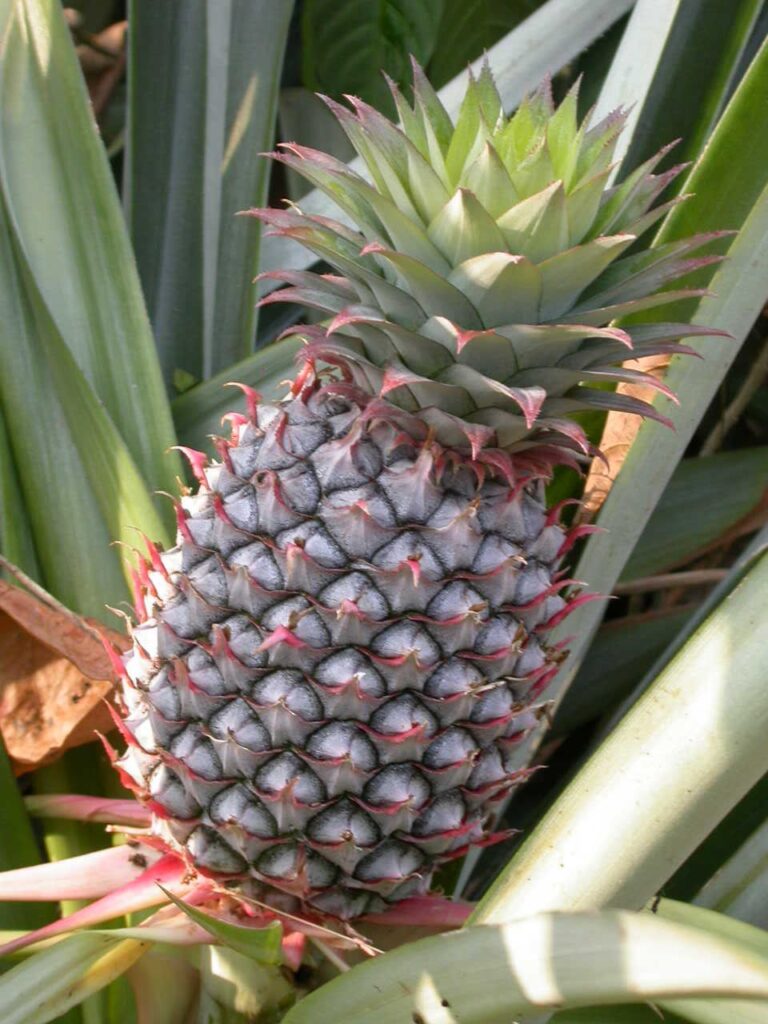
Pau Pámies Grácia, CC BY-SA 4.0
Eswatini (Swaziland)
Pineapple
Ananas

Pau Pámies Grácia, CC BY-SA 4.0
General Description / Cultural Significance
The pineapple’s (ananas) fruity, fresh, and sweet aroma is anything but subtle. First grown commercially in 1954, 50 percent of its production is enjoyed domestically and eaten fresh from the fields, while the rest is distributed around the European Union and South Africa where its uses include but are not limited to skin care products, perfumes, or as an anti-inflammatory. The pineapple plant has a sturdy long stem with waxy and sharp-tipped green leaves that occasionally display streaks of light red or cream. The plant itself can grow between 5-7 feet, however, different varieties can grow longer based on their geography, soil type, and exposure to the sun. While pineapple fields in Eswatini are not a rarity, in some towns, the sight of a pineapple field could indicate that a party awaits. In Eswatini, it is common for song and dance to serve as a ritual to honor the monarchy. Here, the people dress in vibrant clothes to mirror their ancestors, women wear their hair in authentic “beehive” do’s, and men bear traditional axes, acknowledging that tradition has not been abandoned, but instead protected and cherished. Malkerns, one of Eswatini’s many pineapple-rich towns is also home to one of Africa’s largest Amapiano music festivals. For three days, the MTN Bushfire music festival turns the quiet farm town into a dance floor offering vibrant music, a close-knit community, and a world food village offering international and local cuisines alike. Here, pineapples can be all around—in many of the beverages, grilled with various meats, or served as a refreshing pick-me-up.
Climate Change / Conservation Status
Considering that pineapples are a large source of income for both the government and local farmers and vendors, thousands of acres of level soil are reserved to ensure optimal growing conditions and yield a sufficient supply. Seeing as many of these plots have been used and reused since the first pineapples were cultivated, the terrain has inevitably become uneven due to countless harvest rotations and inevitable mountain runoff. In 2016, a critical height difference between water sources and crops was recorded. Desperate to salvage the terrain, Eswatini called on irrigation giant Agrico to reintroduce a consistent water source to their crops. Using the incline formed by the years of runoff, pump stations were installed at the highest points to pump water downhill to the crops in increments. While the effects of climate change including a rise in temperature and increased rainfall are expected to affect the terrain, the performance and yield of pineapples in Eswatini are expected to increase.
Alternate Names
Ananas
Sources
Crane, Johnathan H. “Pineapple Growing in the Florida Home Landscape.” Ask IFAS – Powered by EDIS, University of Florida, edis.ifas.ufl.edu/publication/MG055. Accessed 15 Feb. 2024.
“Customs and Cuisine of the Kingdom of Eswatini (Formerly Swaziland) – Together Women Rise.”
Together Women Rise , 8 Oct. 2023, togetherwomenrise.org/customsandcuisine/customs-and-cuisine-of- the-kingdom-of-eswatini-formerly-swaziland/.
Musi, Nkukhanya. “Eswatini Brings the World to Its Doorstep at the Annual MTN Bushfire.” The African
Mirror.Africa, The African Mirror, 27 June 2023, theafricanmirror.africa/lifestyle/arts-and-
entertainment/eswatini-brings-the-world-to-its-doorstep-at-the-annual-mtn-bushfire/.
Office of the Ambassador, Embassy of the Kingdom of Swaziland, Washington, D.C.
Steyn, Maryna. “Pineapples Live the Sweet Life with Agrico Irrigation Project in Eswatini.” ProAgri
Media, 14 July 2023, www.proagrimedia.com/irrigation/pineapples-live-the-sweet-life-with-agrico-
irrigation-project-in-eswatini/.
Shongwe, Samuel S. “Swaziland’s First National Communication to the United Nations Framework
Convention on Climate Change.” UNFCCC, May 2022,
https://unfccc.int/sites/default/files/resource/swazimet%20report.pdf
“Swaziland Pineapples Exporters & Suppliers – Good Market Prices.” Selina Wamucii, 21 May 2021,
www.selinawamucii.com/produce/fruits-and-vegetables/swaziland-pineapples/#google_vignette.

